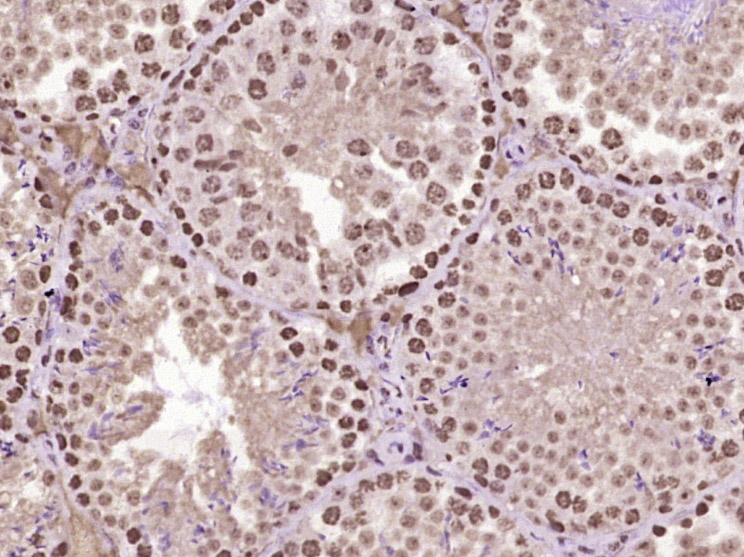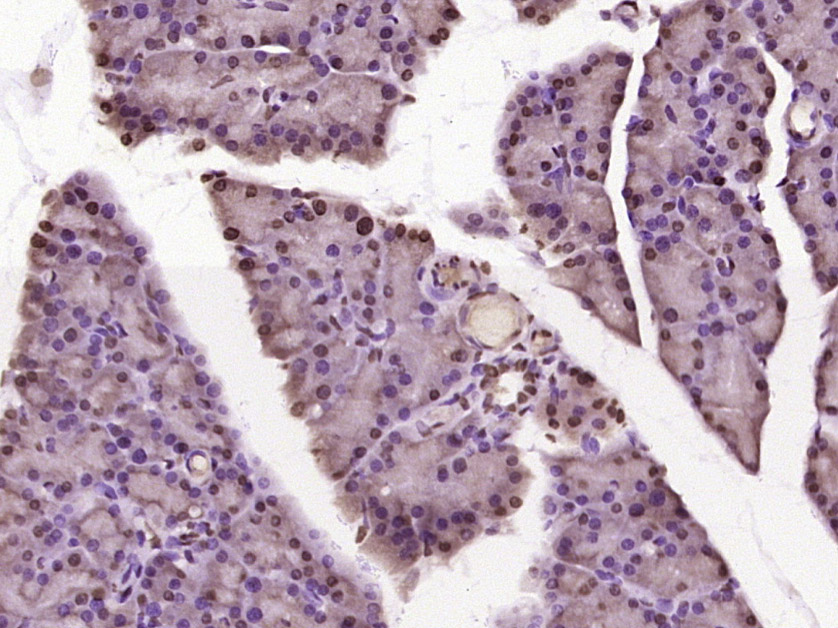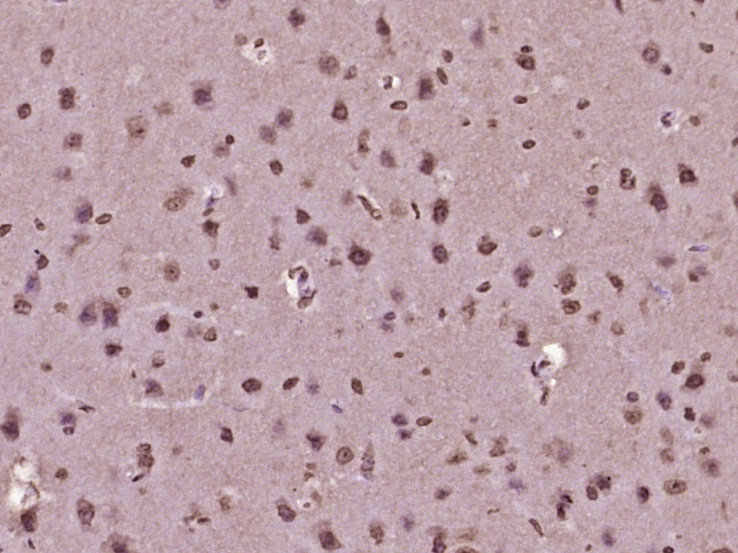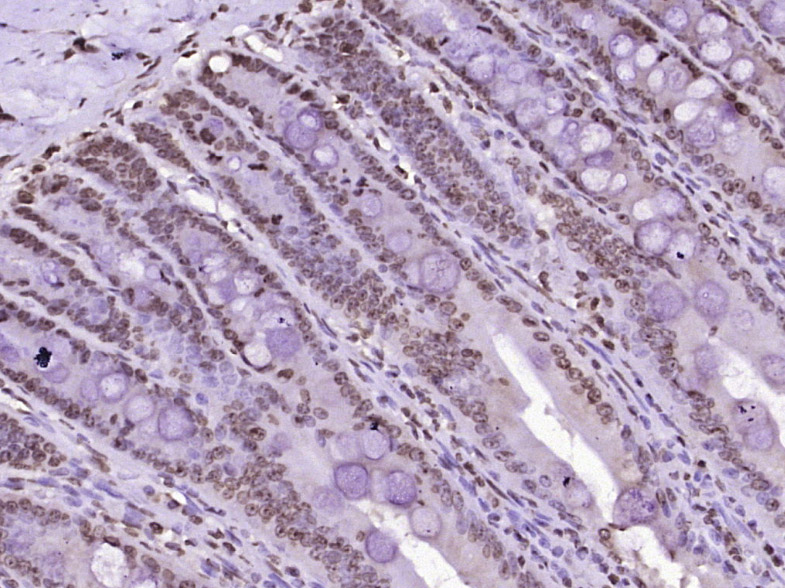
Rabbit Anti-MYO6 antibody
MYO6_HUMAN; Unconventional myosin-VI; Unconventional myosin-6; Myosin 6; Myosin6; KIAA0389; myosin VI; DFNA22; DFNB37; MYHC / MYH6;
View History [Clear]
Details
Product Name MYO6 Chinese Name 肌球蛋白6抗体 Alias MYO6_HUMAN; Unconventional myosin-VI; Unconventional myosin-6; Myosin 6; Myosin6; KIAA0389; myosin VI; DFNA22; DFNB37; MYHC / MYH6; Research Area Neurobiology Signal transduction Extracellular matrix Immunogen Species Rabbit Clonality Polyclonal React Species Mouse, Rat, (predicted: Human, Dog, Pig, Cow, Horse, Rabbit, Sheep, ) Applications ELISA=1:5000-10000 IHC-P=1:100-500 IHC-F=1:100-500 ICC=1:100-500 IF=1:100-500 (Paraffin sections need antigen repair)
not yet tested in other applications.
optimal dilutions/concentrations should be determined by the end user.Theoretical molecular weight 150kDa Cellular localization The nucleus cytoplasmic The cell membrane Extracellular matrix Form Liquid Concentration 1mg/ml immunogen KLH conjugated synthetic peptide derived from human Myosin VI: 1101-1294/1294 Lsotype IgG Purification affinity purified by Protein A Buffer Solution 0.01M TBS(pH7.4) with 1% BSA, 0.03% Proclin300 and 50% Glycerol. Storage Shipped at 4℃. Store at -20 °C for one year. Avoid repeated freeze/thaw cycles. Attention This product as supplied is intended for research use only, not for use in human, therapeutic or diagnostic applications. PubMed PubMed Product Detail This gene encodes a reverse-direction motor protein that moves toward the minus end of actin filaments and plays a role in intracellular vesicle and organelle transport. The protein consists of a motor domain containing an ATP- and an actin-binding site and a globular tail which interacts with other proteins. This protein maintains the structural integrity of inner ear hair cells and mutations in this gene cause non-syndromic autosomal dominant and recessive hearing loss. Alternative splicing results in multiple transcript variants encoding distinct isoforms. [provided by RefSeq, Jul 2014]
Function:
Myosins are actin-based motor molecules with ATPase activity. Unconventional myosins serve in intracellular movements. Myosin 6 is a reverse-direction motor protein that moves towards the minus-end of actin filaments. Has slow rate of actin-activated ADP release due to weak ATP binding. Functions in a variety of intracellular processes such as vesicular membrane trafficking and cell migration. Required for the structural integrity of the Golgi apparatus via the p53-dependent pro-survival pathway. Appears to be involved in a very early step of clathrin-mediated endocytosis in polarized epithelial cells. May act as a regulator of F-actin dynamics. May play a role in transporting DAB2 from the plasma membrane to specific cellular targets. Required for structural integrity of inner ear hair cells.
Subunit:
Homodimer. Binding to calmodulin through a unique insert, not found in other myosins, located in the neck region between the motor domain and the IQ domain appears to contribute to the directionality reversal. This interaction occurs only if the C-terminal lobe of calmodulin is occupied by calcium. Interaction with F-actin/ACTN1 occurs only at the apical brush border domain of the proximal tubule cells (By similarity). Interacts with DAB2. In vitro, the C-terminal globular tail binds a C-terminal region of DAB2. Interacts with CFTR. Forms a complex with CFTR and DAB2 in the apical membrane of epithelial cells. Interacts with OPTN (By similarity).
Subcellular Location:
Cytoplasmic vesicle > clathrin-coated vesicle membrane; Cytoplasmic vesicle > clathrin-coated vesicle membrane. Cell projection > ruffle membrane and Golgi apparatus > trans-Golgi network membrane. Golgi apparatus. Nucleus. Cytoplasm > perinuclear region. Membrane > clathrin-coated pit. Cell projection > ruffle membrane. Also present in endocyctic vesicles, and membrane ruffles. Translocates from membrane ruffles, endocytic vesicles and cytoplasm to Golgi apparatus, perinuclear membrane and nucleus through induction by p53 and p53-induced DNA damage. Recruited into membrane ruffles from cell surface by EGF-stimulation. Colocalizes with DAB2 in clathrin-coated pits/vesicles. Colocalizes with OPTN at the Golgi complex and in vesicular structures close to the plasma membrane.
Tissue Specificity:
Expressed in most tissues examined including heart, brain, placenta, pancreas, spleen, thymus, prostate, testis, ovary, small intestine and colon. Highest levels in brain, pancreas, testis and small intestine. Also expressed in fetal brain and cochlea. Isoform 1 and isoform 2, containing the small insert, and isoform 4, containing neither insert, are expressed in unpolarized epithelial cells.
Post-translational modifications:
Phosphorylation in the motor domain, induced by EGF, results in translocation of MYO6 from the cell surface to membrane ruffles and affects F-actin dynamics. Phosphorylated in vitro by p21-activated kinase (PAK) (By similarity).
DISEASE:
Defects in MYO6 are the cause of deafness autosomal dominant type 22 (DFNA22) [MIM:606346]. DFNA22 is a form of sensorineural hearing loss. Sensorineural deafness results from damage to the neural receptors of the inner ear, the nerve pathways to the brain, or the area of the brain that receives sound information. DFNA22 is progressive and postlingual, with onset during childhood. By the age of approximately 50 years, affected individuals invariably have profound sensorineural deafness. Defects in MYO6 are the cause of deafness autosomal recessive type 37 (DFNB37). Defects in MYO6 are the cause of deafness sensorineural with hypertrophic cardiomyopathy (DFNHCM).
Similarity:
Contains 1 IQ domain. Contains 1 myosin head-like domain.
SWISS:
Q9UM54
Gene ID:
4646
Database links:Entrez Gene: 4646 Human
Entrez Gene: 17920 Mouse
Omim: 600970 Human
SwissProt: Q9UM54 Human
SwissProt: Q64331 Mouse
Unigene: 149387 Human
Unigene: 4040 Mouse
Product Picture
Bought notes(bought amounts latest0)
No one bought this product
User Comment(Total0User Comment Num)
- No comment






 +86 571 56623320
+86 571 56623320
 +86 18668110335
+86 18668110335

